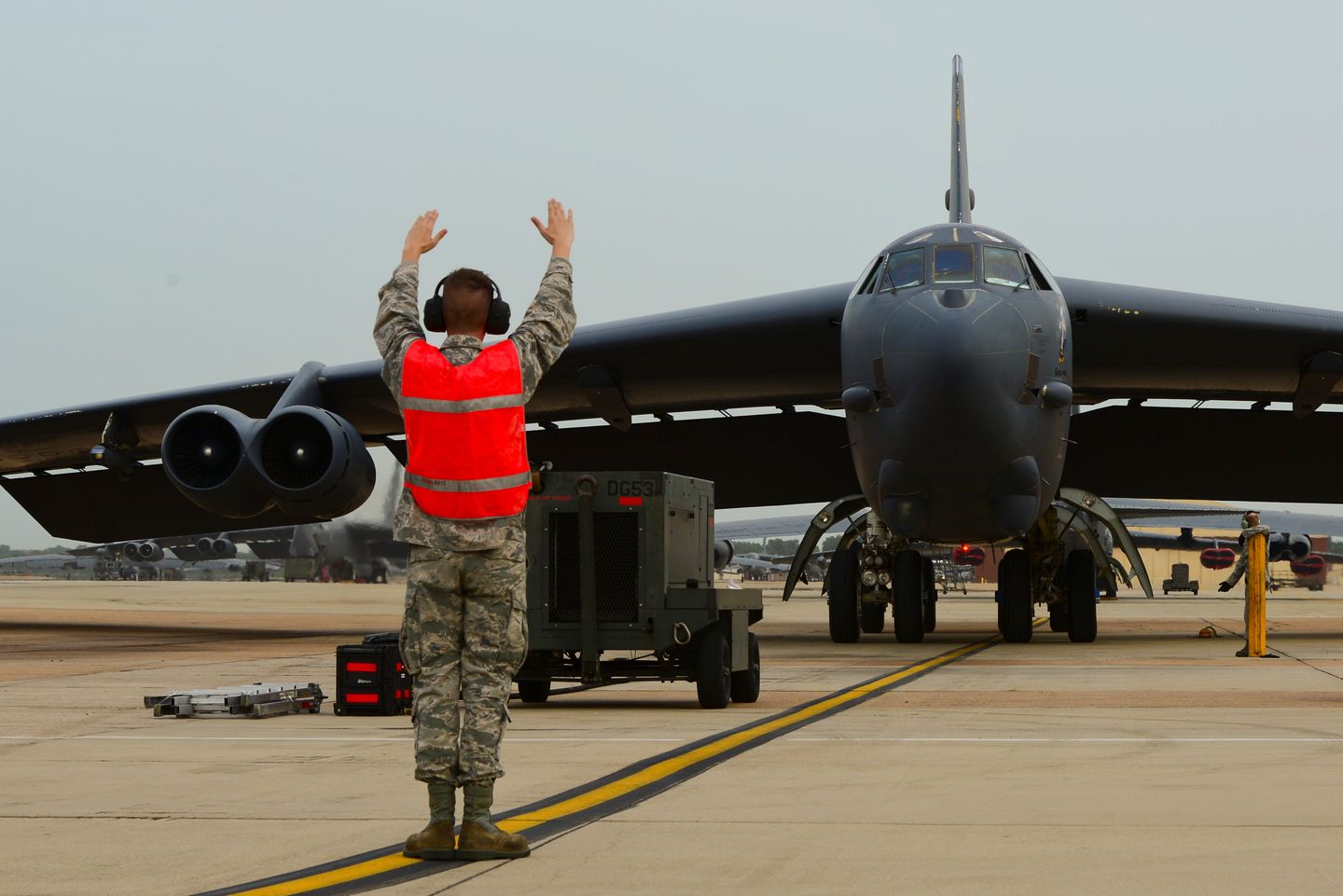
Ukraine’s bold military attack on Russian strategic bombers using drones launched from trucks is raising new concerns about the vulnerability of American bombers to Chinese and Russian missiles fired from shipping containers.
The June 1 attack involved what Ukrainian military authorities said were 117 one-way, remotely piloted attack drones against four Russian strategic bomber bases. At least 40 aircraft were destroyed in the daring raid.
The operation dubbed “Spider Web” was planned for over a year and successfully carried out using big-rig trucks that were parked near the bomber bases after infiltrating Russia.
The drones were launched from trailers disguised as shipping containers, according to videos of the attack posted online.
Aircraft destroyed in the raid included 12 strategic bombers, including eight Tu-95s and four Tu-22s, Reuters reported. Several others were likely damaged.
Israel also was able to penetrate Iran’s borders and set up a secret facility inside Iran that used close-in access to launch precision drone strikes against key targets in Tehran.
Both attacks are raising concerns among U.S. security officials about the vulnerability of U.S. bombers and other military targets in the United States.
A Google Earth image of Barksdale Air Force Base, Louisiana, shows 29 B-52s open to drone or missile strikes.
At Whiteman Air Force Base, Missouri, no B-2 stealth bombers are visible in satellite images. But 16 B-1 bombers can be seen in the open at Dyess Air Force, Texas, according to Google imagery.
The threat of an attack on the U.S. homeland from missiles hidden in shipping containers and fired from the deck of a freighter is real and growing, security analysts say.
“The recent Ukrainian containerized drone attack deep across Russia provides a stark warning that a similar threat from the People’s Republic of China also poses to the United States,” said retired Navy Capt. Jim Fanell, a former Pacific Fleet intelligence chief.
The Pentagon’s latest China military power report states that China is developing a missile launcher “that can fit inside a standard commercial shipping container for covert employment of the YJ-18 aboard merchant ships.”
The YJ-18 is a supersonic missile that poses a major threat to the Navy’s Pacific Fleet warships as well as land targets.
The Chinese missile was first unveiled at the Zhuhai Airshow, also known as the China International Aviation & Aerospace Exhibition, in 2022, when the missile was called the Container-Type Sea Defense Combat System, or CSDCS, which is similar to the Club K.
The system is deployed in a shipping container and loaded on ships, and can fire multiple types of Chinese missiles.
China is expected to employ the missile as part of an integrated battle management network of sensors in aircraft, satellites, radar and other systems.
The sensors will send targeting data to the weapon that will then be able to accurately at U.S. ports, warships, logistics facilities and aircraft.
The military is concerned that the container missiles could be used for a similar surprise strike like Spider Web against Navy forces in the Indo-Pacific.
“Given the significant volume of containers that have entered the United States from the PRC, without inspection, the risk of a similar attack must be taken seriously,” Capt. Fanell said, using the acronym for the People’s Republic of China.
Missile strikes from container ships could result in serious damage to U.S. military installations and critical infrastructure, such as the electric grid, communications networks and transportation systems.
Such attacks are seen by military intelligence as a key element of war planning by the People’s Liberation Army in a potential conflict over Taiwan.
The goal of the attacks would be to limit the U.S. response to an invasion of Taiwan or attacks against allies in the Indo-Pacific, including Hawaii and the West Coast, Capt. Fanell said.
“This is a serious risk and demands inspections of the millions of containers from the PRC on our shores, as well as a vetting of any new and incoming containers,” he said.
Retired Air Force Gen. Glen VanHerck, a former commander of Northern Command, said the United States needs to remain vigilant at home and abroad as missile and drone threats increase.
Creative thinking regarding defenses is also needed as foreign adversaries “will absolutely attempt to utilize our current vulnerabilities for their asymmetric opportunities,” he said.
“The pace of change in warfare has advanced enormously with the conflict in Ukraine. We must adapt to this fact and change to meet the threat,” Gen. VanHerck said.
The Ukrainian drone strike on Russia showed expertise in the design, logistics and preparations for the attack.
“End game defeat is a small portion of the overall challenge,” he said. “For the U.S., this is a whole-of-nation effort to prevent something similar.”
The Russian container missile has been known for at least a decade and is called the Club-K. It fires either a Kh-35 anti-ship cruise missile or Kalibr medium-range land attack cruise missile.
Both are hidden inside what appears to be an ordinary 20-foot shipping container.
The Club-K has been a concern for the U.S. military since at least 2010, when the missile system was first spotted being marketed for export by Moscow.
U.S. intelligence units in charge of monitoring arms proliferation were first alerted to the threat by a marketing video produced by a Russian company that makes the missiles.
The missiles also pose a proliferation danger as the systems can be sold by Russia to Iran, which in the past has supplied its Chinese-made anti-ship missiles to Hezbollah.
Tehran is currently a major missile supplier to Houthi rebels in Yemen, who have used them against shipping in the Red Sea.
The Russian arms conglomerate Concern Morinformsystem-Agat stated on its website in marketing the container missile that with Club-K and Club-U missile systems, “almost every type of ship can be turned into a missile ship.”
Defense officials told The Washington Times in 2019 that Russia is deploying long-range, precision Kalibr cruise missiles to the western Atlantic that will allow Moscow to target Washington and other East Coast cities with conventional or nuclear attacks.
The missiles include the Kalibr land attack cruise missile on both warships and missile submarines that Moscow plans to use in Atlantic patrols near the United States, sorties that were once routine during the Cold War.
The Kalibr has a range of between 930 miles and 1,550 miles, according to the Navy Office of Naval Intelligence.
The export version of the Kalibr is the Club-K deployed in containers.
That range means a freighter, warship, or submarine located 1,000 miles off the U.S. coast could target all American cities stretching from Boston to Miami and as far west as Chicago with the Kalibr or Club-K.
China has also been developing container missiles for at least a decade.
U.S. defense officials revealed in 2019 that China is building the YJ-18C, a long-range land attack variant of the anti-ship missile launched from a shipping container.
In the spring of 2019, U.S. intelligence agencies reported internally that the new container missile was in flight testing stages. It was reportedly to be deployed in containers that appear from the outside to be standard international shipping containers used throughout the world for moving millions of tons of goods, often on the deck of large freighters.
The YJ-18C is a PLA version of the Russian Club-K cruise missile that is also disguised in a shipping container launcher. Israel is also reportedly working on a container-launched missile called the Lora.
For China, its extensive network of commercial port facilities around the world, including at both ends of the Panama Canal, ratchets up the threat of container-launched missiles.
Chinese ports are also located in the Bahamas and Jamaica, which could be used to deploy ships carrying the containerized YJ-18C.
Beijing is also expanding its commercial footprint through the Belt and Road Initiative to build infrastructure in Africa, South America and Asia.
It is not known if test firings of the container missile have been carried out. However, China’s military conducted exercises in October 2024 that involved the use of the decks of civilian container ships to launch WZ-10 attack helicopters.
A report by the Pentagon’s Defense Science Board, made public in January, warned that China and Russia have penetrated critical U.S. infrastructure and plan attacks on it in a future war.
The U.S. military, however, is ill-prepared for attacks that a task force of experts warned will cause “potentially severe” delays and disruptions to U.S. military force projection. The military also risks losing a future war, the report concluded.
“If their attacks on the homeland are successful on the scale and in the time frames they seek, U.S. forces could be prevented from winning — or possibly even getting to — the forward fight altogether,” the report said.
Retired Rear Adm. Mark Montgomery, said the Ukrainian drone strike was an effort to take Russian strength — layers of jamming and air defense systems — out of play through positioning truck launch platforms inside their inner defense ring.
“Container ships offer a similar advantage — possible launches from seemingly civilian ships or ports,” said Adm. Montgomery, now with the Foundation for Defense of Democracies’ Center on Cyber and Technology Innovation.
“Complicating this, we have almost no homeland missile defense outside the Washington, D.C., area, and the cost to defend our national critical infrastructure from both cruise or hypersonic conventional weapons with terrestrial-based missile defense systems would be prohibitively expensive,” he said.
A long-term solution would be to deploy space-based systems backed by land-based sensors that can engage missiles rapidly, he said.
It is not known if the Army is deploying its own missiles launched in shipping containers.
The online publication The War Room reported last week that a containerized missile launcher was spotted during President Trump’s recent speech at Fort Bragg, North Carolina. The launcher appeared designed to fire artillery rockets and ballistic missiles.
Rick Fisher, a China security analyst with the International Assessment and Strategy Center, said China has built the world’s largest containerized missile threat that is not limited to the 248-mile-range YJ-18.
“Containerized missiles give China, Russia and its rogue state partners new options for directly or indirectly attacking the United States and its allies,” Mr. Fisher said.
In 2023, Chinese state media published a graphic showing the missile manufacturer China Aerospace Science and Industry Corporation also adapted the subsonic, 125-mile range YJ-83, the 248-mile range supersonic YJ-12, and the subsonic 621-mile range YJ-62 for firing from standard shipping containers.
“China, however, takes the ultimate prize for containerized missile threats,” Mr. Fisher said.
In late 2021, the Chinese space launch company OneSpace produced a video that sought to market their what was called a “smart container” capable of launching a solid fuel, space launch vehicle that could easily be used to fire an intercontinental ballistic missile, Mr. Fisher said.
The containerized space launcher was also shown being launched from a ship, a railcar, as well as a truck transport.
Mr. Fisher said that since the video was published, OneSpace appears to have backed off selling the container launchers. “But it would take considerable intelligence resources to ensure they had not sold ‘containerized’ ICBMs to rogue regimes like the Houthis, Iran, North Korea and Venezuela,” he said.


![Former Bravo Star Charged After Violent Assault Using a Rock-Filled Sock in Tennessee Walmart [WATCH]](https://www.right2024.com/wp-content/uploads/2025/07/Former-Bravo-Star-Charged-After-Violent-Assault-Using-a-Rock-Filled-350x250.jpg)




![Karoline Leavitt Levels CNN's Kaitlan Collins and Other Legacy Media Reporters [WATCH]](https://www.right2024.com/wp-content/uploads/2025/07/Karoline-Leavitt-Levels-CNNs-Kaitlan-Collins-and-Other-Legacy-Media-350x250.jpg)
![Man Arrested After Screaming at Senators During Big Beautiful Bill Debate [WATCH]](https://www.right2024.com/wp-content/uploads/2025/06/Man-Arrested-After-Screaming-at-Senators-During-Big-Beautiful-Bill-350x250.jpg)

![Illegal Alien Walked Free After Decapitating Woman, Abusing Corpse for Weeks [WATCH]](https://www.right2024.com/wp-content/uploads/2025/07/1753013138_Illegal-Alien-Walked-Free-After-Decapitating-Woman-Abusing-Corpse-for-350x250.jpg)






